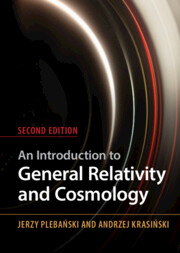Book contents
- Frontmatter
- Contents
- The scope of this text
- Preface to the second edition
- Acknowledgments
- 1 How the theory of relativity came into being (a brief historical sketch)
- Part I Elements of differential geometry
- Part II The theory of gravitation
- 12 The Einstein equations and the sources of a gravitational field
- 13 The Maxwell and Einstein–Maxwell equations and the Kaluza–Klein theory
- 14 Spherically symmetric gravitational fields of isolated objects
- 15 Relativistic hydrodynamics and thermodynamics
- 16 Relativistic cosmology I: general geometry
- 17 Relativistic cosmology II: the Robertson–Walker geometry
- 18 Relativistic cosmology III: the LemaÎtre–Tolman geometry
- 19 Relativistic cosmology IV: simple generalisations of L–T and related geometries
- 20 Relativistic cosmology V: the Szekeres geometries
- 21 The Kerr metric
- 22 Relativity enters technology: the Global Positioning System
- 23 Subjects omitted from this book
- 24 Comments to selected exercises and calculations
- References
- Index
17 - Relativistic cosmology II: the Robertson–Walker geometry
from Part II - The theory of gravitation
Published online by Cambridge University Press: 30 May 2024
- Frontmatter
- Contents
- The scope of this text
- Preface to the second edition
- Acknowledgments
- 1 How the theory of relativity came into being (a brief historical sketch)
- Part I Elements of differential geometry
- Part II The theory of gravitation
- 12 The Einstein equations and the sources of a gravitational field
- 13 The Maxwell and Einstein–Maxwell equations and the Kaluza–Klein theory
- 14 Spherically symmetric gravitational fields of isolated objects
- 15 Relativistic hydrodynamics and thermodynamics
- 16 Relativistic cosmology I: general geometry
- 17 Relativistic cosmology II: the Robertson–Walker geometry
- 18 Relativistic cosmology III: the LemaÎtre–Tolman geometry
- 19 Relativistic cosmology IV: simple generalisations of L–T and related geometries
- 20 Relativistic cosmology V: the Szekeres geometries
- 21 The Kerr metric
- 22 Relativity enters technology: the Global Positioning System
- 23 Subjects omitted from this book
- 24 Comments to selected exercises and calculations
- References
- Index
Summary
The Robertson–Walker metrics are presented as the simplest candidates for the models of our observed Universe. The Friedmann solutions of the Einstein equations (which follow when a R–W metric is taken as an ansatz), with and without the cosmological constant, are derived and discussed in detail. The Milne–McCrea Newtonian analogues of the Friedmann models are derived. Horizons in the R–W models are discussed following the classical Rindler paper. The conceptual basis of the inflationary models is critically reviewed.
Keywords
Information
- Type
- Chapter
- Information
- An Introduction to General Relativity and Cosmology , pp. 255 - 288Publisher: Cambridge University PressPrint publication year: 2024
